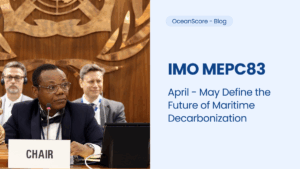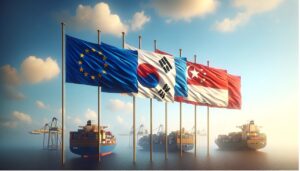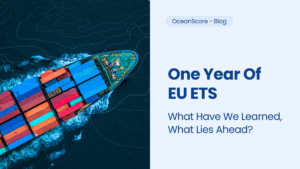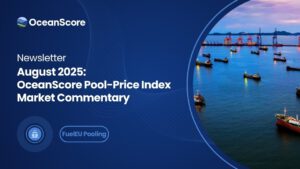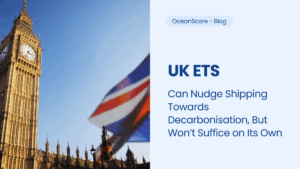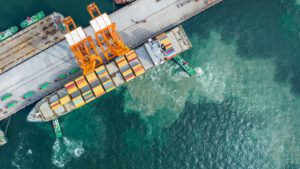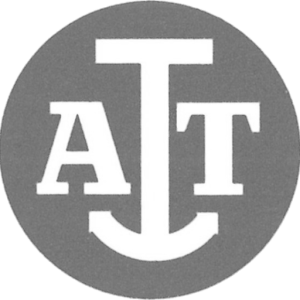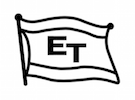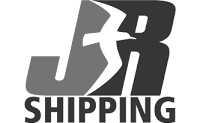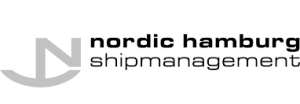OceanScore has been assessing early experiences as companies adapt to the EU ETS post-implementation, based on feedback from over 70 clients. Several pain points have emerged, and here we present some of the lessons learned and our advice for best practice.
Pain point #1: who is best placed to handle EU ETS compliance?
Ultimate responsibility for EU ETS compliance lies with the shipowner, but the Document of Compliance (DOC) holder – typically the technical manager – already performs emissions reporting under the EU’s MRV and IMO’s DCS regimes. It is therefore more efficient for the DOC holder to take responsibility for reporting and other related tasks such as allocation of EUAs to charterers.
Best practice: delegate responsibility to the DOC holder as soon as possible to stay ahead of those that do not as aligning ETS with MRV responsibilities simplifies compliance and leverages existing expertise in the organization. This is especially beneficial for SPV-based ownership structures.
Pain point #2: how to get EUA accounts up and running?
Opening a Union Registry trading account for EUAs requires a lot of paperwork and has proven time-consuming, with extra requirements for non-European entities. Maritime Operator Holding Accounts (MOHAs) have the same functionality, and are easier and faster to open, though have been delayed in some countries due to issues such as legislative oversight even after the allocation of Administering Authorities where MOHAs can be opened.
Best practice: prioritize opening a single MOHA over multiple trading accounts, even if you need to wait a bit longer. This strategy simplifies the management of EUAs, especially in scenarios involving corporate ownership structures or multiple vessels under a single manager.
Pain point #3: how to steer clear of contractual complexity?
EU ETS clauses must be included in charter parties, but some major charterers have made demands for intricate reporting cycles that are not doable with available data feeds from data providers. Also, EUA settlements in cash can incur pricing risk due to high (even intraday) carbon price volatility.
Some SHIPMAN agreements have proven too complicated and demanding in relation to the EU ETS, with one client in the bulk business questioning why a manager should need a monthly forecast of EUAs: “There is not much they can do with this and the volume of EUAs they need to provide is really limited anyways.”
Best practice: avoid complex structures with diverging emission reporting and EUA requesting cycles in charter parties, and demand settlements in EUAs to avoid pricing risk. Similarly, SHIPMAN clauses should clearly define ETS responsibilities and be kept simple when discussing them beforehand.
Pain point #4: how to access and trade EUAs?
Acquiring EUAs can be complex as one must balance compliance needs against unpredictable market prices that fluctuate according to various external factors such as global events, weather patterns and energy trends.
This raises questions about how to access EUAs, how and when to buy, and how many.
Shipowners will need to buy EUAs but mostly in small volumes in cases such as periods of unemployment, offhire or when charterers settle for EUAs in cash. Our experience has also shown there are minimal price variations between different EUA providers.
Best practice: take a pragmatic approach by buying EUAs as needed based on operational requirements rather than speculate on market price movements. Over-the-counter, rather than exchange, trading works better for small volumes. Align with one or two trading partners to compare relative pricing, rather than waste time shopping around for the best EUA price.
Pain point #5: how to ensure proper data management?
Data disparities can arise due to discrepancies between EU ETS rules and the MRV regime in areas such as treatment of offhires, recognition of transshipment ports and differentiation between commercial and MRV voyages. Inadequate data management can lead to unexpected EUA discrepancies and the risk of non-compliance.
The challenge lies in ensuring digital compatibility, particularly in the availability of comprehensive APIs and the ability to offer detailed voyage and time-based analytics.
Best practice: select a data provider with advanced digital capabilities to handle EU ETS-specific requirements, including versatile APIs, to ensure data management supports seamless ETS compliance. The data partner should be able to understand the nuanced deviations from MRV norms, accurately track emissions for offhires and specific voyage types, and provide detailed event reports for precise voyage differentiation.
Pain point #6: who will manage the many internal processes?
The EU ETS requires input from multiple company departments, with data and APIs handled by fleet management, charter party EUA requests by commercial and EUA accounts by accounting. This raises the dilemma of who should take overall responsibility, which can oscillate like a hot potato between different departments. There is no universal solution due to the unique structures and complexities of each company.
Best practice: management of EU ETS processes requires a multidisciplinary approach with coordination between different departments in which each has clear responsibilities and timelines. Outsourcing of these tasks to a specialized service provider such as OceanScore can be considered a beneficial strategic move as it enables the company to focus on its core operations while ensuring compliance with the EU ETS.
These suggested best practices are intended to serve as a guide to navigate an increasingly complex regulatory environment. We are grateful to our customers for providing valuable insights as we accompany them on this journey. OceanScore will continue to learn as we move forward, enhancing and adjusting our solutions in the process.




